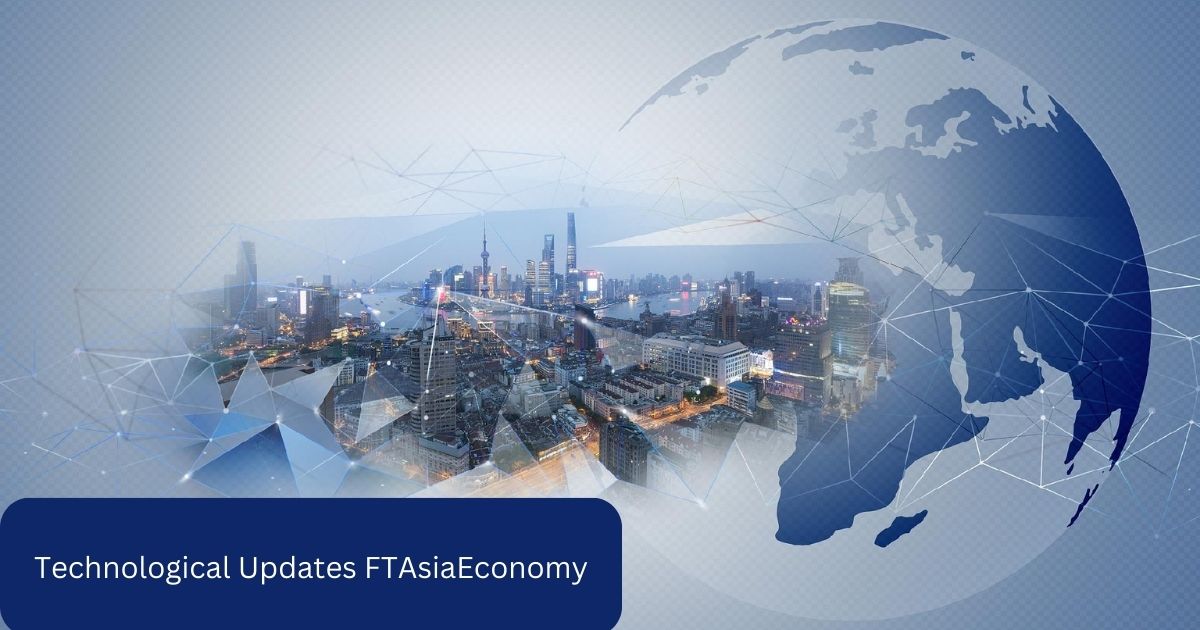Technological Updates FTAsiaEconomy is your go-to source for the latest advancements and trends shaping the tech landscape across Asia. Whether it’s groundbreaking innovations, emerging startups, or shifts in the digital economy, we bring you insightful coverage that keeps you informed and ahead of the curve. Stay connected with the rapidly evolving world of technology and discover how it influences the economic dynamics in Asia with Technological Updates FTAsiaEconomy.
Technology is changing quickly in Asia, and these changes are having a big impact on the region’s economy. Many Asian countries are working hard to adopt new technologies like artificial intelligence, robotics, and 5G networks. These tools are helping businesses work more efficiently and create new products and services. At the same time, governments are investing in digital infrastructure to make sure more people can access the internet and use online services.
Technology, FTAsiaEconomy, Role
Technology is playing a huge role in shaping Asia’s economy. It’s like a powerful engine driving growth and change across the region. From smartphones that connect millions of people to the internet, to advanced robots in factories, tech is transforming how businesses operate and how people work and live. Many Asian countries are racing to become tech leaders, investing heavily in areas like artificial intelligence, 5G networks, and digital payment systems. This push for innovation is helping create new industries, improve productivity, and open up fresh opportunities for entrepreneurs and workers alike.
At the same time, technology is helping solve some of Asia’s biggest challenges. For example, in agriculture, farmers are using apps and sensors to grow crops more efficiently. In healthcare, telemedicine is bringing doctors to remote areas via video calls. And in education, online learning platforms are making it easier for people to gain new skills.
But it’s not all smooth sailing – the rapid pace of tech change is also causing some growing pains. Governments and businesses are grappling with issues like data privacy, cybersecurity, and how to make sure the benefits of technology are shared fairly across society. Still, most agree that embracing technology is crucial for Asia’s future economic success.
Technological updates FTAsiaEconomy Most Important Technologies and Their Impacts
Digital Transformation

Digital transformation is changing how businesses and governments work in Asia. It’s like giving the whole economy a tech makeover. Companies are moving their operations online, using cloud computing, and finding new ways to serve customers digitally. This shift is making businesses more efficient and helping them reach more people. For example, many small shops now sell their products through apps and websites, not just in physical stores.
Governments are also going digital, offering services online so people don’t have to wait in long lines or fill out paper forms. While this change brings many benefits, it also means people need to learn new skills to keep up. Some older ways of doing things are disappearing, which can be tough for those who aren’t used to technology.
5G and Connectivity
5G is the newest and fastest type of mobile internet, and it’s spreading across Asia. It’s like supercharging the internet on your phone and other devices. With 5G, people can download movies in seconds, play online games without lag, and connect more devices to the internet at once.
This super-fast connection is also helping businesses. Factories can use it to control robots more precisely, cities can manage traffic better, and doctors can even perform surgeries remotely. Many Asian countries are racing to build 5G networks because they believe it will help their economies grow. However, setting up 5G is expensive and takes time. Some worry that rural areas might get left behind if they don’t get 5G as quickly as cities.
Artificial Intelligence/Machine Learning
AI and machine learning are like teaching computers to think and learn on their own. In Asia, these technologies are being used in all sorts of ways. Banks use AI to detect fraud and decide who should get loans. Factories use it to predict when machines need repairs. Online shops use it to recommend products you might like. AI is even helping in healthcare, analyzing medical images to spot diseases early.
Many Asian countries see AI as a key to future economic growth and are investing heavily in research and development. However, there are also concerns. Some worry that AI might replace human jobs, especially in industries like manufacturing and customer service. There’s also debate about how to use AI responsibly and ensure it doesn’t discriminate against certain groups of people.
Also Read: Retro Bowl Unblocked Games 66
The impact of Technological Updates’ effect on the FTAsiaEconomy
The impact of technological updates on Asia’s economy has been profound and far-reaching. These advancements are reshaping industries, creating new opportunities, and presenting challenges across the region. Here’s a breakdown of their effects:
Economic Growth: Tech updates are boosting productivity and efficiency in many sectors. This is leading to faster economic growth in countries that are quick to adopt new technologies. For example, countries with strong digital infrastructure are seeing their e-commerce and fintech sectors boom.
Job Market Shifts: While technology is creating new jobs in fields like software development, data analysis, and digital marketing, it’s also automating some traditional roles. This is causing a shift in the job market, with a growing demand for tech-savvy workers. Many Asian countries are focusing on retraining programs to help workers adapt.
Innovation and Startups: The tech boom is fueling a startup culture across Asia. Cities like Singapore, Bangalore, and Shenzhen are becoming innovation hubs, attracting investors and talented entrepreneurs. This is helping diversify economies and reduce dependence on traditional industries.
Global Competitiveness: Countries that are leading in areas like AI, 5G, and robotics are gaining a competitive edge in the global market. This is helping some Asian economies move up the value chain, from manufacturing-based to knowledge-based economies.
Digital Divide: While tech updates are benefiting many, there’s a risk of widening inequality. Urban areas and larger companies often adopt new technologies faster, potentially leaving rural areas and small businesses behind. Governments are grappling with how to ensure more inclusive tech-driven growth.
International Relations: Technology is also influencing trade and diplomacy. Issues like data governance, tech standards, and cybersecurity are becoming important in international negotiations and trade agreements among Asian countries and with the rest of the world.
Environmental Impact: Some tech updates are helping Asian countries address environmental challenges. For instance, smart city technologies are improving energy efficiency, while advancements in renewable energy are helping reduce reliance on fossil fuels.
Development and Business Ventures

Technological updates are sparking a wave of new business ventures across Asia. Startups are popping up like mushrooms after rain, especially in tech hubs like Singapore, Bangalore, and Seoul. These new companies are tackling everything from fintech to e-commerce, ride-sharing to edtech. Big companies aren’t sitting still either – they’re investing heavily in R&D and partnering with startups to stay competitive.
For example, traditional banks are teaming up with fintech firms to offer digital banking services. Governments are getting in on the action too, setting up innovation parks and offering tax breaks to attract tech companies. This boom in tech-driven business is reshaping Asia’s economic landscape, creating new industries and challenging old ones. However, it’s not all smooth sailing. Many startups fail, and there’s fierce competition for funding and talent. Still, the overall trend is creating more opportunities for entrepreneurs and investors alike.
Employment and Skills Development
The tech revolution is turning the job market on its head in Asia. On one hand, it’s creating loads of new jobs in fields like software development, data analysis, and digital marketing. Tech giants like Alibaba and Tencent are hiring thousands of workers each year. But on the flip side, some traditional jobs are disappearing as machines and AI take over tasks. This shift is causing a bit of a headache – there’s a growing gap between the skills workers have and what employers need. To bridge this gap, governments and businesses are going all out on skills development.
Countries like Singapore and South Korea are offering coding bootcamps and subsidizing tech courses. Companies are ramping up their training programs too. The goal is to create a workforce that can keep up with the pace of tech change. It’s not just about technical skills either – soft skills like creativity and adaptability are becoming more important as routine tasks get automated. For workers, it’s becoming clear that learning new skills isn’t just nice to have – it’s a must to stay employable in this fast-changing economy.
Future Prospects of Technological Updates for Asia’s Economy
Technological updates offer significant potential for Asia’s economic growth. New tech could boost productivity across industries, transform cities into innovation hubs, and improve healthcare and education. Financial technology may increase financial inclusion, while green tech could help meet climate goals. These advancements could enhance Asia’s global competitiveness, potentially shifting more economic power to the region. Smart cities, improved infrastructure, and increased efficiency in various sectors could lead to a higher quality of life and sustained economic development.
Challenges of Technological Updates for Asia’s Economy
Despite the opportunities, Asia faces several challenges in adopting new technologies. Job displacement due to automation is a major concern, along with a widening skills gap. The digital divide could worsen inequality if not addressed. Data security and privacy issues will likely increase as economies become more digital.
Regulatory frameworks need to evolve quickly, which can be complex. High infrastructure costs, potential brain drain, and ethical concerns around new tech also pose challenges. Some countries may struggle with over-reliance on foreign technology. Additionally, managing the environmental impact of increased tech use will be crucial. Balancing these challenges with the potential benefits will be key to successfully leveraging technological updates for economic growth.
FAQ’s
What are the environmental implications of rapid tech adoption in Asia?
Increased energy consumption and e-waste are concerns. However, tech can also drive green solutions and improve resource efficiency across industries.
How will technological updates impact job markets in Asia?
While some jobs may be automated, new roles in tech sectors will emerge. Countries need to focus on reskilling and education to prepare their workforce.
Can smaller Asian economies compete in the global tech race?
Yes, by focusing on niche areas and fostering innovation-friendly policies. Collaboration with larger economies and investment in education are key strategies.
What role will 5G play in Asia’s economic development?
5G will enable faster, more reliable connections, boosting sectors like IoT and smart cities. It could significantly enhance productivity and create new business opportunities.
How can Asian countries address the digital divide?
Governments can invest in digital infrastructure and provide subsidies for tech access. Public-private partnerships can help extend digital services to underserved areas.
Summary
Technological updates present a double-edged sword for Asia’s economy. They offer significant opportunities for growth, including increased productivity, smart cities, and improved services across sectors. However, these advancements also bring challenges such as potential job displacement, skills gaps, and digital inequality.
Success will depend on how well Asian countries can balance innovation with social concerns, invest in education and infrastructure, and adapt regulations. If managed effectively, these updates could significantly boost Asia’s global economic competitiveness and quality of life. The key lies in strategic planning, collaboration, and policies that promote inclusive technological growth while addressing potential drawbacks.


